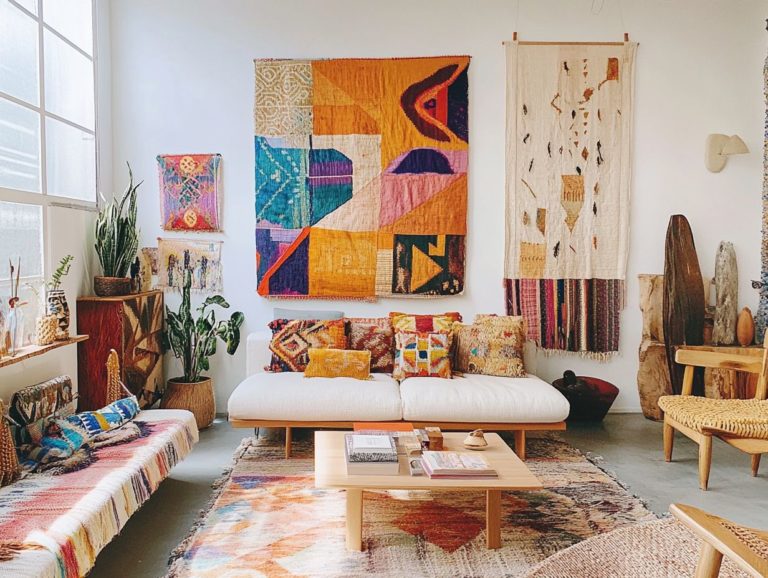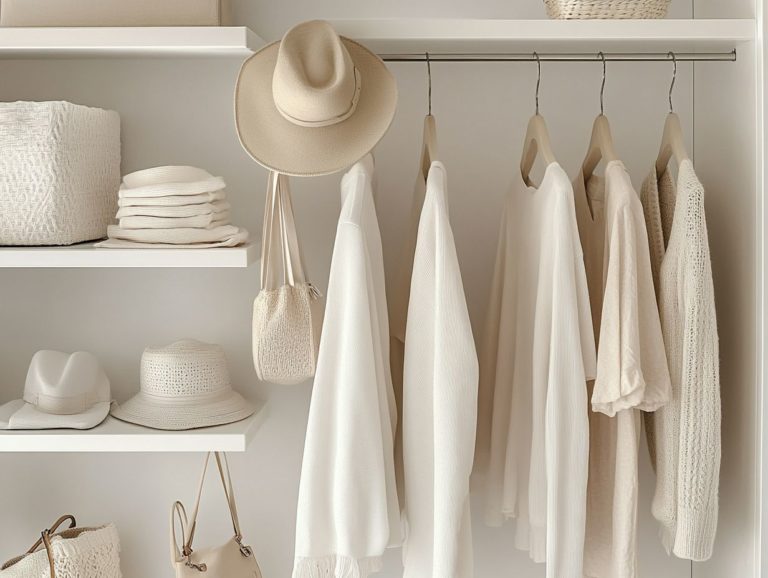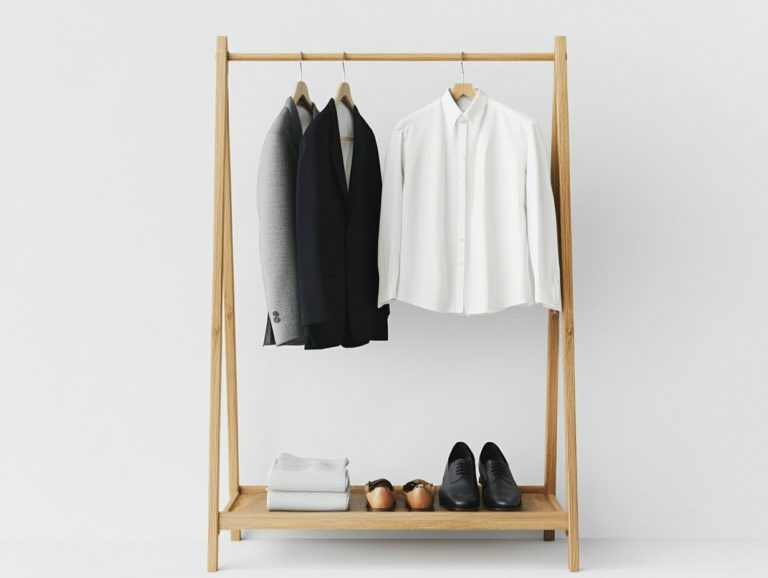How to Make Your Minimalist Wardrobe More Sustainable
In today’s fast-paced fashion world, the appeal of minimalism provides a refreshing perspective that blends style with sustainability.
This article explores the core principles of minimalist fashion and highlights the importance of sustainable practices in an industry often burdened by waste and environmental damage.
We will look at your wardrobe, choose eco-friendly materials, and share tips on revitalizing your clothing without expanding your closet. Our goal is to guide you toward a conscious and stylish lifestyle.
Are you ready to transform your wardrobe? Discover how embracing minimalism can enhance your fashion sense and positively impact our planet.
Contents
- Key Takeaways:
- The Importance of Sustainable Fashion
- Environmental and Social Impacts of Fast Fashion
- How to Transition to a Sustainable Minimalist Wardrobe
- Key Principles for Building a Sustainable Wardrobe
- Eco-Friendly Materials and Brands to Consider
- Sustainable Fabrics and Ethical Brands
- Tips for Maintaining and Refreshing Your Wardrobe
- Extending the Lifespan of Your Clothing
- Ways to Update Your Wardrobe Without Buying New
- The Impact of Minimalism on Sustainable Fashion
- Frequently Asked Questions
- Want to make your minimalist wardrobe sustainable? Here’s how!
- What type of materials should I look for in sustainable clothing?
- How can I incorporate sustainable fashion into my minimalist wardrobe?
- Is thrifting a sustainable option for my minimalist wardrobe?
- What should I do with clothing items that I no longer want in my minimalist wardrobe?
- How can I maintain a sustainable minimalist wardrobe in the long term?
Key Takeaways:
- Transitioning to a sustainable minimalist wardrobe starts with assessing and decluttering your current items.
- Extending the lifespan of your clothing and updating your wardrobe without buying new are key principles for building sustainability.
- Choosing eco-friendly materials and supporting ethical brands are important to reducing waste and consumption in the fashion industry.
The Importance of Sustainable Fashion
Sustainable fashion is essential in our wardrobe choices, emphasizing the need to minimize environmental damage from clothing consumption while promoting ethical practices.
As awareness of the environmental costs of fast fashion grows, consumers are encouraged to adopt eco-friendly practices and make conscious wardrobe selections in their daily lives. This shift benefits the environment and supports sustainable brands and ethical fashion initiatives prioritizing quality over quantity.
Environmental and Social Impacts of Fast Fashion
Fast fashion has significant negative environmental and social impacts, leading to pollution, waste, and labor exploitation. This underscores the urgent need for sustainable fashion.
The rapid production cycles of fast fashion accelerate clothing lifecycles, resulting in increased waste and detrimental environmental effects. Serious social issues related to labor rights and fair wages also arise.
This cycle contributes to garment disposal, with millions of tons of discarded clothing filling landfills each year. The production processes release toxic chemicals into waterways, destroying ecosystems and contaminating communities.
Labor exploitation, such as long hours and low pay, is common in factories in developing countries producing these garments.
The rise of sustainable fashion offers hope by emphasizing ethical consumption and encouraging support for brands that prioritize environmental sustainability and fair labor practices.
How to Transition to a Sustainable Minimalist Wardrobe
Transitioning to a sustainable minimalist wardrobe involves choosing clothing that prioritizes quality over quantity while embracing mindful wardrobe principles.
This journey encourages individuals to buy less and focus on essential pieces that can be mixed and matched in various ways. Create a versatile, eco-friendly wardrobe that minimizes clothing’s environmental impact.
Assessing Your Current Wardrobe
Assessing your wardrobe is a crucial step in creating a mindful closet that aligns with sustainable fashion principles. This process helps identify items that can be reused or donated.
Look at each item: Is it useful? Comfortable? Does it fit your style? Have you worn it in over a year? If yes, it may be time to let it go. Consider setting up a space for items you plan to donate, making the process easier and motivating.
This approach helps maintain a clutter-free closet and contributes to sustainability by giving your clothes a new life.
Start today and make a positive impact!
Key Principles for Building a Sustainable Wardrobe
The principles of a sustainable wardrobe emphasize prioritizing quality over quantity. Focus on essential clothing items that align with ethical fashion.
Purchase garments made from sustainable fabrics and support eco-friendly brands. Choosing versatile pieces that can be styled in multiple ways fosters creativity and reduces the temptation to overbuy.
Opt for items with timeless designs to ensure they remain fashionable long after purchase. This ultimately minimizes waste.
Select clothing from brands that adopt a system where clothes can be reused or recycled. Look for those with fair labor practices and transparency in their supply chains.
This ensures that fashion reflects personal expression while making ethical choices. It also encourages others to make similar decisions, helping to establish eco-friendly alternatives as the norm.
Eco-Friendly Materials and Brands to Consider
Eco-friendly materials and brands are characterized by their use of sustainable fabrics. Examples include organic cotton, Tencel, and other natural materials.
These fabrics help reduce environmental impact and enhance clothing quality. Numerous ethical brands, including Patagonia, Nisolo, and For Days, are leading the charge.
They promote a sustainable fashion industry by offering products made from eco-friendly materials and advocating for a responsible clothing lifecycle.
Sustainable Fabrics and Ethical Brands
Researching sustainable fabrics and ethical brands is crucial. This helps consumers combat the negative effects of fast fashion.
Focus on organic cotton and other sustainable materials. Brands like Rent the Runway and Depop are leading the way in promoting sustainable practices.
They offer fashionable alternatives while incorporating sustainable fabrics, such as Tencel and recycled polyester, into their collections.
These brands consider both the visual appeal of their garments and their environmental impact. Companies like Everlane and Reformation prioritize supply chain transparency.
They showcase how their production methods support good labor practices. By emphasizing sustainability and ethical material sourcing, these brands attract customers who care about their choices and the planet.
Discussing alternatives like hemp and bamboo is essential to diversifying fashion’s material sources.
Tips for Maintaining and Refreshing Your Wardrobe
Tips for sustainable clothing maintenance and renewal can enhance the longevity of your garments. They also help reduce your overall clothing footprint.
Simple actions such as repairing clothes, using eco-friendly laundry products, and organizing clothing swaps can significantly contribute to a sustainable fashion lifestyle.
Extending the Lifespan of Your Clothing
Act now to make your wardrobe more sustainable.
Ways to Update Your Wardrobe Without Buying New
Ready to refresh your wardrobe without spending a dime? It’s not only good for the planet, but it sparks creativity too!
Options such as clothing swaps, second-hand shopping, and fashion rentals offer stylish alternatives. By borrowing from friends or exploring thrift shops, you can refresh your wardrobe while significantly reducing your carbon footprint.
These approaches allow individuals to uncover unique items, each with its own story. They promote a sense of community through shared fashion experiences.
Clothing swaps can transform into social events where friends gather to exchange styles. Renting clothes for special occasions is cost-effective and helps mitigate waste associated with fast fashion.
Thrift shops provide a treasure hunt experience, yielding vintage and distinctive pieces at lower prices. Overall, these methods enable fashion enthusiasts to lower their carbon footprint and support the growing eco-conscious movement.
The Impact of Minimalism on Sustainable Fashion
Minimalism significantly influences sustainable fashion by encouraging individuals to consume fewer clothing items and adopt a more mindful wardrobe aligned with sustainable principles.
Embracing a minimalist mindset allows consumers to prioritize essential pieces. This not only reduces wardrobe size but also dramatically decreases their overall impact on the environment while promoting sustainable choices.
Reducing Waste and Consumption through Minimalism
Reducing waste and consumption in fashion through minimalism involves adopting eco-friendly practices and mindful consumption strategies. Prioritizing quality over quantity and maximizing the use of clothing can positively impact sustainable fashion and contribute to saving the planet.
This lifestyle encourages valuing each clothing item and selecting pieces that can be mixed and matched. Choose high-quality, durable garments. Techniques such as creating a capsule wardrobe help streamline clothing choices, minimizing excess and making it easier to mix and match items.
Second-hand shopping and clothing swaps extend the life cycle of garments, fostering a circular economy that moves away from fast fashion. As conscious consumers who prioritize sustainability, we can reduce waste and inspire others to consider the environmental implications of their shopping habits.
Why Thrift and Rent? Sustainable Fashion Made Fun!
Fashion rental and second-hand shopping are becoming increasingly popular eco-friendly options in sustainable fashion. These choices allow consumers to enjoy trendy pieces without contributing to fast fashion waste.
Platforms like Rent the Runway and Depop provide users with access to a wide range of stylish garments while promoting sharing and reusing. By choosing these alternatives, individuals save money and significantly reduce their carbon footprint, making a positive impact on the environment.
The excitement of discovering unique items in second-hand stores or rental boutiques adds a personalized touch to one’s wardrobe, encouraging creativity and individuality. These choices support a circular economy, where products are kept in use longer, ultimately reducing textile waste.
Engaging in eco-conscious practices can inspire others to think critically about their fashion consumption, creating a ripple effect toward a more sustainable future.
Frequently Asked Questions
Want to make your minimalist wardrobe sustainable? Here’s how!
Start by decluttering your current wardrobe and only keep items that you truly love and wear frequently. This will reduce overall consumption and waste.
What type of materials should I look for in sustainable clothing?
Look for materials like organic cotton, linen, hemp, and bamboo. These materials are natural and have a smaller impact on the environment compared to synthetic options.
How can I incorporate sustainable fashion into my minimalist wardrobe?
Invest in high-quality, timeless pieces that are made from sustainable materials. This will reduce the need to constantly replace and update your wardrobe.
Is thrifting a sustainable option for my minimalist wardrobe?
Yes! Thrifting is a great way to make your minimalist wardrobe more sustainable. By purchasing secondhand clothing, you extend the lifespan of the item and reduce the demand for new clothing production.
What should I do with clothing items that I no longer want in my minimalist wardrobe?
Instead of throwing away unwanted clothing items, consider donating them to a thrift store or clothing donation program. This gives your items a new life and reduces the amount of clothing going to landfills.
How can I maintain a sustainable minimalist wardrobe in the long term?
Aim to buy less and choose quality over quantity for new purchases. Regularly assess your wardrobe and declutter to keep it minimal and sustainable.
Have tips for sustainable fashion or experiences with minimalism? Share them with us!





